Experimental Analysis of the R744/R404A Cascade Refrigeration System with Internal Heat Exchanger. Part 2: Exergy Characteristics
Abstract
:1. Introduction
2. Experimental Apparatus and Data Reduction
2.1. Experimental Apparatus
2.2. Data Reduction
2.3. Uncertainties
3. Results and Discussion
3.1. Effect of the Degree of Subcooling and Superheating
3.1.1. Effect of the Degree of Subcooling
3.1.2. Effect of Degree of Superheating
3.2. Effect of Condensation and Evaporation Temperature
3.2.1. Effect of Condensation Temperature
3.2.2. Effect of Evaporation Temperature
3.3. Effect of Evaporation Temperature of Cascade Heat Exchanger
3.4. Effect of Internal Heat Exchanger Efficiency
3.4.1. Effect of Internal Heat Exchanger Efficiency at R404A Cycle
3.4.2. Effect of Internal Heat Exchanger Efficiency at R744 Cycle
3.5. Comparison of Experimental and Pereformance Analysis Data
4. Conclusions
- The COP, exergy efficiency, and exergy destruction rate of a CRS have a close relationship. The lower the total exergy destruction rate of the system, the higher the exergy efficiency of the system and accordingly the COP of the system is also improved.
- In the CRS, since the optimum cascade evaporation temperature exists (about −16 °C), it can be said that the limit point, that is, the cascade evaporation temperature with the maximum COP of the system, is the optimum point at about −16 °C. Therefore, at this optimum point (i.e., optimum cascade evaporation temperature or evaporation pressure), the exergy destruction rate of the cascade heat exchanger is at its minimum value. In other words, it should be noted that when the cascade evaporation temperature is the optimum point, the exergy destruction rate of the R744 compressor and the cascade heat exchanger is minimal.
- In case R404A with high GWP cannot be applied, R448A and R449A, which can be replaced one-to-one with R404A, are recommended as alternative refrigerants for R404A.
Funding
Data Availability Statement
Conflicts of Interest
Nomenclature
| Symbols | |
| COP | Coefficients of performance |
| Exergy rate (kW) | |
| i | Specific enthalpy (kJ/kg) |
| Mass flow rate (kg/s) | |
| P | Pressure (kPa) |
| Q | Heat capacity (kW) |
| s | Specific entropy (kJ/(kg·K)) |
| T | Temperature (°C) |
| W | Power consumption (kW) |
| Greek Symbols | |
| Difference | |
| η | Efficiency |
| Superscripts | |
| M | Mechanical |
| T | Thermal |
| Subscripts | |
| C | Condensation, Condenser |
| CAS | Cascade heat exchanger |
| COM | Compressor |
| D | Destruction |
| E | Evaporation, Evaporator |
| Exergy | |
| F | Fuel |
| IHX | Internal heat exchanger |
| k | kth compenent |
| P | Product |
| Ratio | Ratio |
| R404A | R404A refrigeration cycle |
| R744 | R744 refrigeration cycle |
| SUC | Subcooling |
| SUH | Superheating |
| SYS | Cascade refrigeration system |
References
- Sawalha, S. Using CO2 in supermarket refrigeration. ASHRAE 2005, 47, 26–30. [Google Scholar]
- Veiby, O.J. Internal Records, Documentation in the ICA Supermarket Chain in Norway. Oslo, Norway, 2003.
- Queiroz, M.V.A.; Panato, V.H.; Antunes, A.H.P.; Parise, J.A.R.; Bandarra Filho, E.P. Experimental comparison of a cascade refrigeration system operating with R744/R134a and R744/R404A. In Proceedings of the International Refrigeration and Air-Conditioning Conference at Purdue, West Lafayette, IN, USA, 11–14 July 2016; pp. 1–10. Available online: http://docs.lib.purdue.edu/iracc/1785 (accessed on 7 November 2016).
- Lee, T.-S.; Liu, C.-H.; Chen, T.-W. Thermodynamic analysis of optimal condensing temperature of cascade-condenser in CO2/NH3 cascade refrigeration systems. Int. J. Refrig. 2006, 29, 1100–1108. [Google Scholar] [CrossRef]
- Gholamian, E.; Hanafizadeh, P.; Ahmadi, P. Advanced exergy analysis of a carbon dioxide ammonia cascade refrigeration system. Appl. Therm. Eng. 2018, 137, 689–699. [Google Scholar] [CrossRef]
- Aminyavari, M.; Najafi, B.; Shirazi, A.; Rinaldi, F. Exergetic, economic and environmental (3E) analyses, and multiobjective optimization of a CO2/NH3 cascade refrigeration system. Appl. Therm. Eng. 2014, 65, 42–50. [Google Scholar] [CrossRef]
- Rangel, V.B.; Almeida, A.G.S. Cascade refrigeration system for low temperatures using natural fluids. Therm. Eng. 2021, 20, 20–26. [Google Scholar] [CrossRef]
- Pan, M.; Zhao, H.; Liang, D.; Zhu, Y.; Liang, Y.; Bao, G. A review of the cascade refrigeration system. Energies 2020, 13, 2254. [Google Scholar] [CrossRef]
- Sun, Z.; Wang, Q.; Xie, Z.; Liu, S.; Su, D.; Cui, Q. Energy and exergy analysis of low GWP refrigerants in cascade refrigeration system. Energy 2019, 170, 1170–1180. [Google Scholar] [CrossRef]
- Roy, R.; Mandal, B.K. Energetic and exergetic performance comparison of cascade refrigeration system using R170/R161 and R41/R404A as refrigerant pairs. Heat Mass Transf. 2019, 55, 723–731. [Google Scholar] [CrossRef]
- Kumar, V. Comparative analysis of cascade refrigeration system based on energy and exergy using different refrigerant pairs. J. Therm. Eng. 2020, 6, 106–116. [Google Scholar] [CrossRef] [Green Version]
- Zhang, Y.; He, Y.; Wang, Y.; Wu, X.; Jia, M.; Gong, Y. Experimental investigation of the performance of an R1270/CO2 cascade refrigerant system. Int. J. Refrig. 2020, 114, 175–180. [Google Scholar] [CrossRef]
- Jeon, M.J. Experimental analysis of the R744/R404A cascade refrigeration system with internal heat exchanger. Part 1: Coefficient of performance characteristics. Energies 2021, 14, 6003. [Google Scholar] [CrossRef]
- Ahern, J.E. Exergy Method of Energy Systems Analysis; John Wiley and Sons: New York, NY, USA, 1980. [Google Scholar]
- Bai, T.; Yu, J.; Yan, G. Advanced exergy analysis on a modified auto-cascade freezer cycle with an ejector. Energy 2016, 113, 385–398. [Google Scholar] [CrossRef]
- Vatani, A.; Mehrpooya, M.; Palizdar, A. Advanced exergetic analysis of five natural gas liquefaction processes. Energy Convers. Manag. 2014, 78, 720–737. [Google Scholar] [CrossRef]
- Morosuk, T.; Tsatsaronis, G. Graphical models for splitting physical exergy. In Proceedings of the ECOS 2005-Proceedings of the 18th International Conference on Efficiency, Cost, Optimization, Simulation, and Environmental Impact of Energy Systems, Trondheim, Norway, 20–22 June 2005; Tapir Academic Press: Trondheim, Norway, 2005; pp. 377–384. [Google Scholar]
- Morosuk, T.; Tsatsaronis, G.; Zhang, C. Conventional thermodynamic and advanced exergetic analysis of a refrigeration machine using a Voorhees’ compression process. Energy Convers. Manag. 2012, 60, 143–151. [Google Scholar] [CrossRef]
- Lazzaretto, A.; Tsatsaronis, G. SPECO: A systematic and general methodology for calculating efficiencies and costs in thermal systems. Energy 2006, 31, 1257–1289. [Google Scholar] [CrossRef]
- Bejan, A.; Tsatsaronis, G.; Moran, M. Thermal Design and Optimization; John Wiley & Sons: New York, NY, USA, 1996. [Google Scholar]
- Tsatsaronis, G. Definitions and nomenclature in exergy analysis and exergoeconomics. Energy 2007, 32, 249–253. [Google Scholar] [CrossRef]
- Sun, Z.; Liang, Y.; Liu, S.; Ji, W.; Zang, R.; Liang, R.; Guo, Z. Comparative analysis of thermodynamic performance of a cascade refrigeration system for refrigerant couples R41/R404A and R23/R404A. Appl. Energy 2016, 184, 19–25. [Google Scholar] [CrossRef]
- Morosuk, T.; Tsatsaronis, G. Advanced exergetic evaluation of refrigeration machines using different working fluids. Energy 2009, 34, 2248–2258. [Google Scholar] [CrossRef]
- Kline, S.J.; McClintock, F.A. Describing Uncertainties in Single Sample Experiments. Mech. Eng. 1953, 75, 3–8. [Google Scholar]
- Moffat, R. Describing the uncertainties in experimental results. Exp. Therm. Fluid Sci. 1988, 1, 3–17. [Google Scholar] [CrossRef] [Green Version]
- Yılmaz, D.; Sınar, Ü.; Özyurt, A.; Yılmaz, B.; Mancuhan, E. Ultra Düşük Sıcaklıklarda Çalışan İki Kademeli Bir Soğutma Sisteminde Aşırı Soğutma ve Isıtmanın Performansa Etkilerinin Sayısal İncelenmesi. Afyon Kocatepe Univ. J. Sci. Eng. 2017, 17, 1172–1180. [Google Scholar] [CrossRef]
- Mosaffa, A.H.; Garousi Farshi, L.; Infante Ferreira, C.A.; Rosen, M.A. Exergoeconomic and environmental analyses of CO2/NH3 cascade refrigeration systems equipped with different types of flash tank intercoolers. Energy Convers. Manag. 2016, 117, 442–453. [Google Scholar] [CrossRef] [Green Version]
- Hendri; Nurhasanah, R.; Prayudi; Suhengki. Energy and Exergy Analysis of Cascade Refrigeration System Using MC22 and MC134 on HTC, R404A and R502 on LTC. J. Adv. Res. Fluid Mech. Therm. Sci. 2021, 80, 73–83. [Google Scholar] [CrossRef]
- Parekh, A.D.; Tailor, P.R. Thermodynamic analysis of cascade refrigeration, system using R12-R13, 290-R23 and R404A-R23. World Acad. Sci. Eng. Technol. Int. J. Mech. Mechatron. Eng. 2014, 8, 1351–1356. [Google Scholar]
- Kilicarslan, A.; Hosoz, M. Energy and irreversibility analysis of a cascade refrigeration system for various refrigerant couples. Energy Convers. Manag. 2010, 51, 2947–2954. [Google Scholar] [CrossRef]
- Yilmaz, F.; Selbaş, R. Comparative thermodynamic performance analysis of a cascade system for cooling and heating applications. Int. J. Green Energy 2019, 16, 674–686. [Google Scholar] [CrossRef]
- Dokandari, D.A.; Hagh, A.S.; Mahmoudi, S.M.S. Thermodynamic investigation and optimization of novel ejector-expansion CO2/NH3 cascade refrigeration cycles (novel CO2/NH3 cycle). Int. J. Refrig. 2014, 46, 26–36. [Google Scholar] [CrossRef]
- Dopazo, J.A.; Fernández-Seara, J.; Sieres, J.; Uhía, F.J. Theoretical analysis of a CO2-NH3 cascade refrigeration system for cooling applications at low temperatures. Appl. Therm. Eng. 2009, 29, 1577–1583. [Google Scholar] [CrossRef] [Green Version]
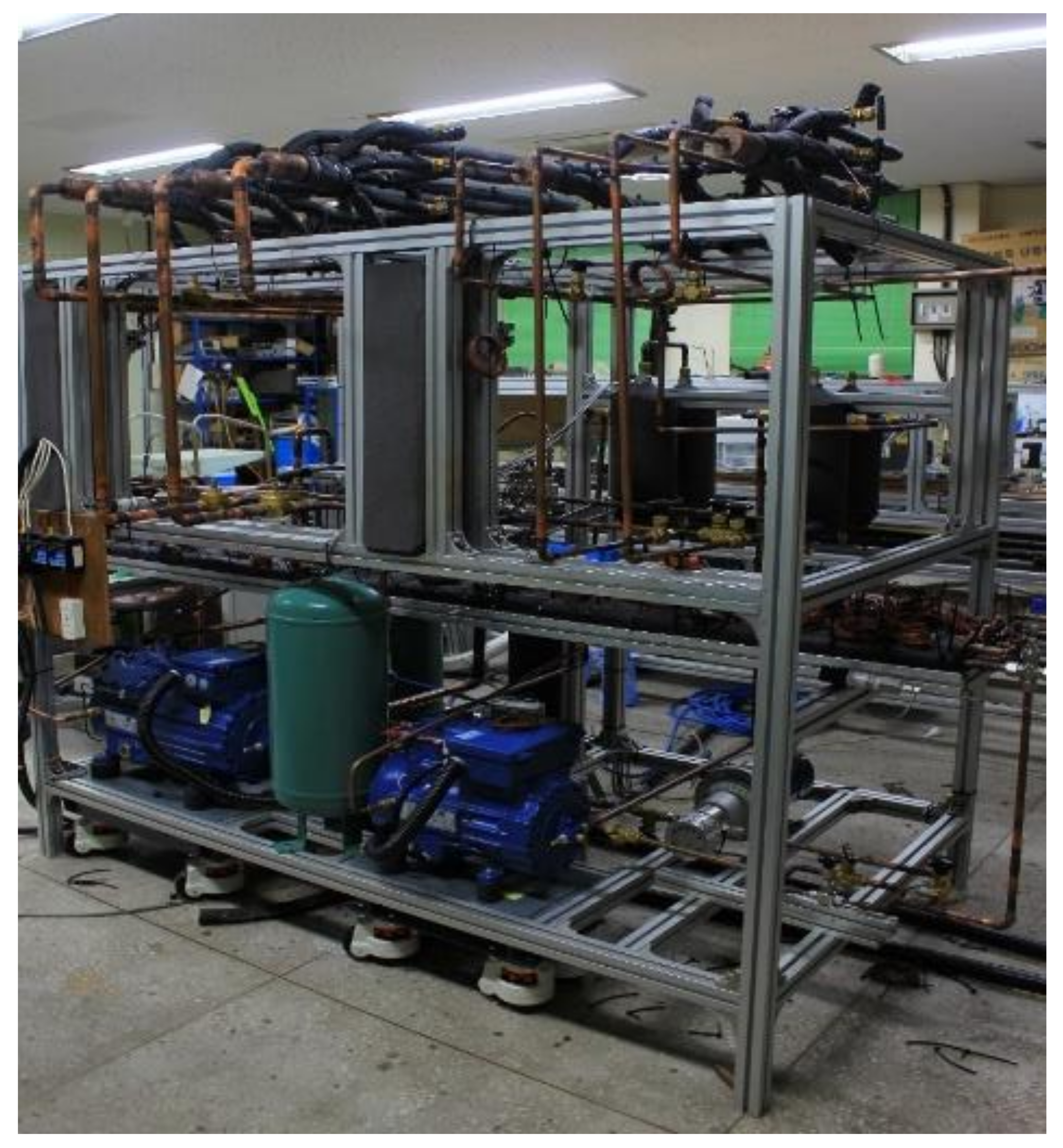
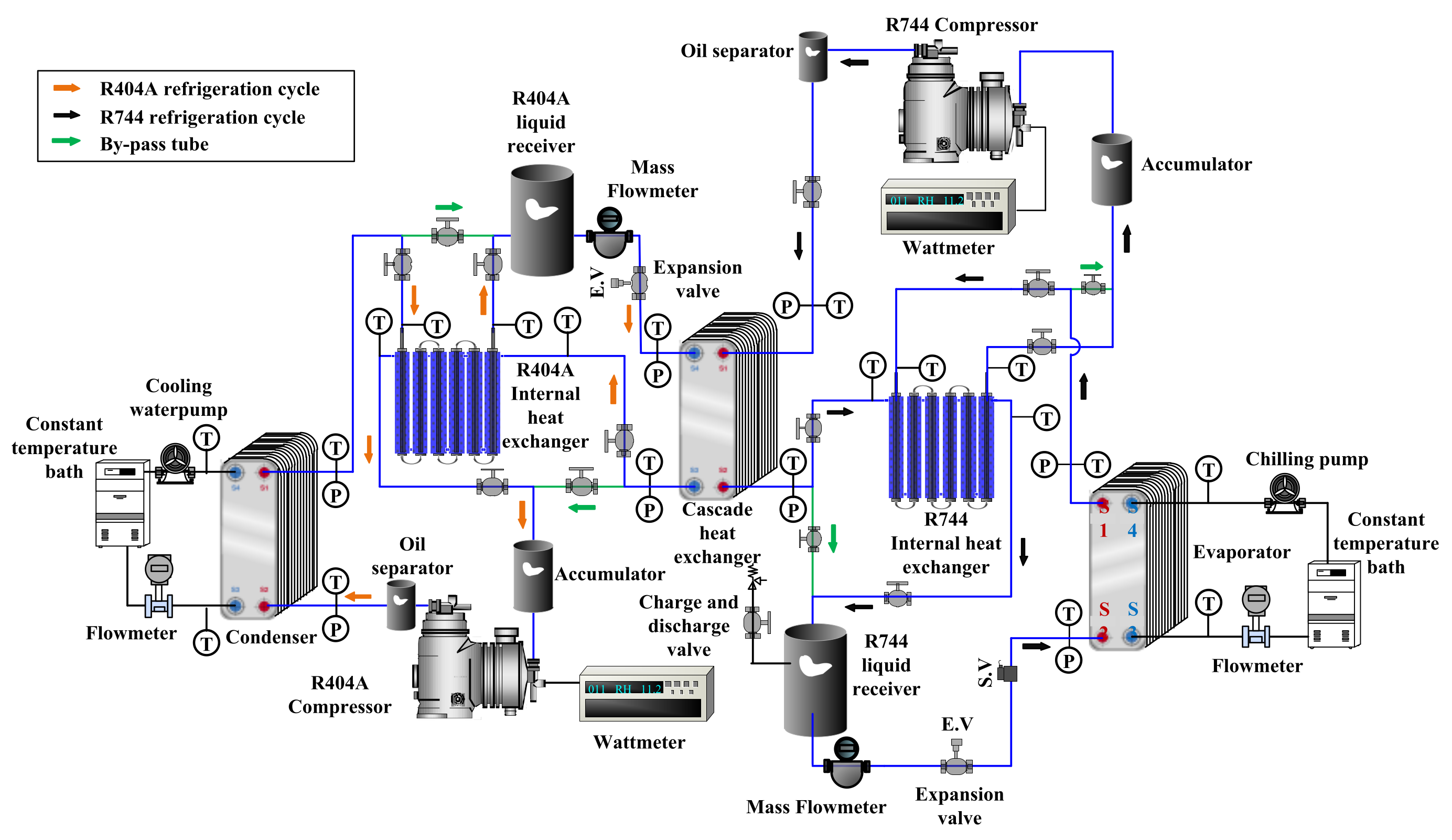
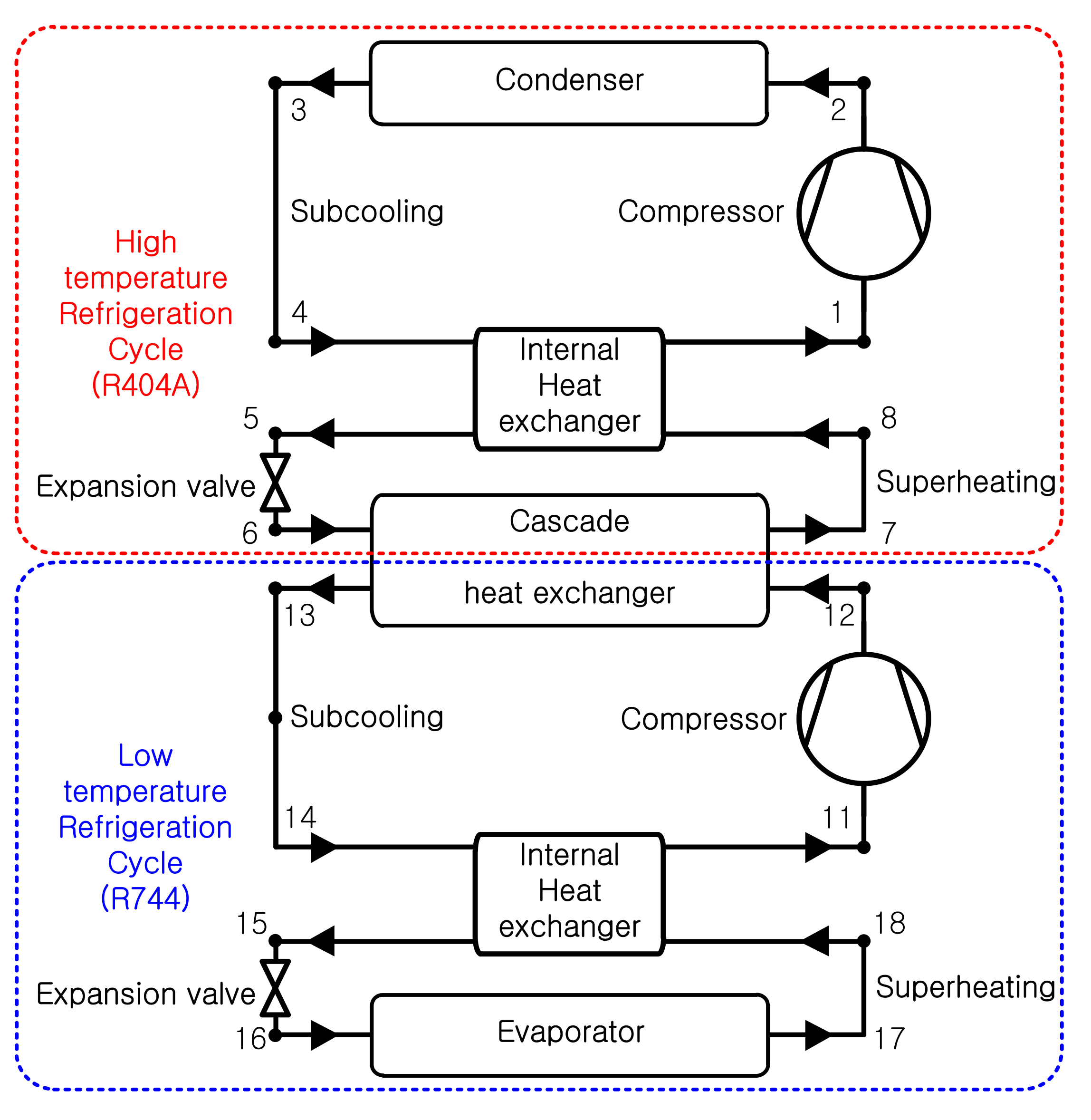
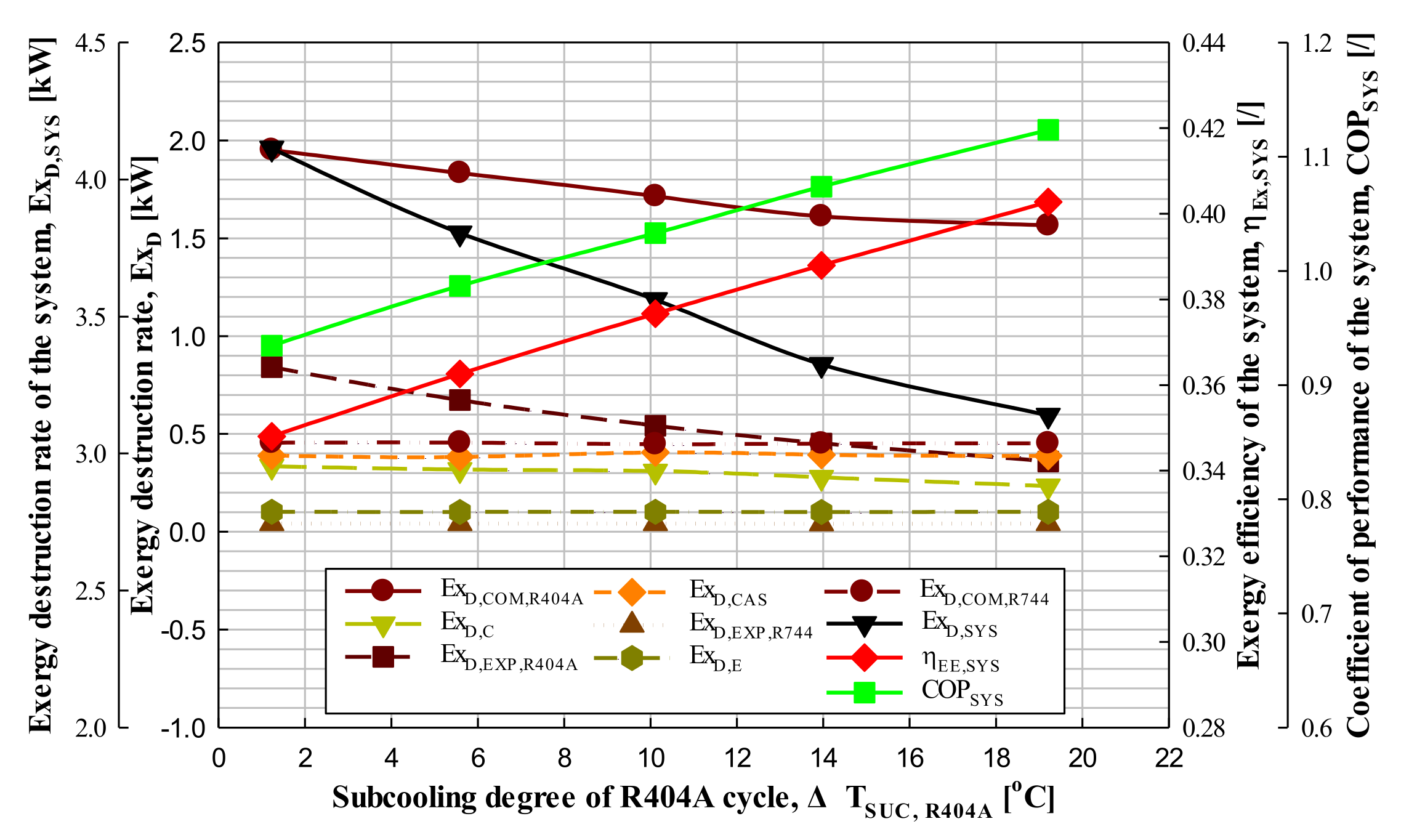
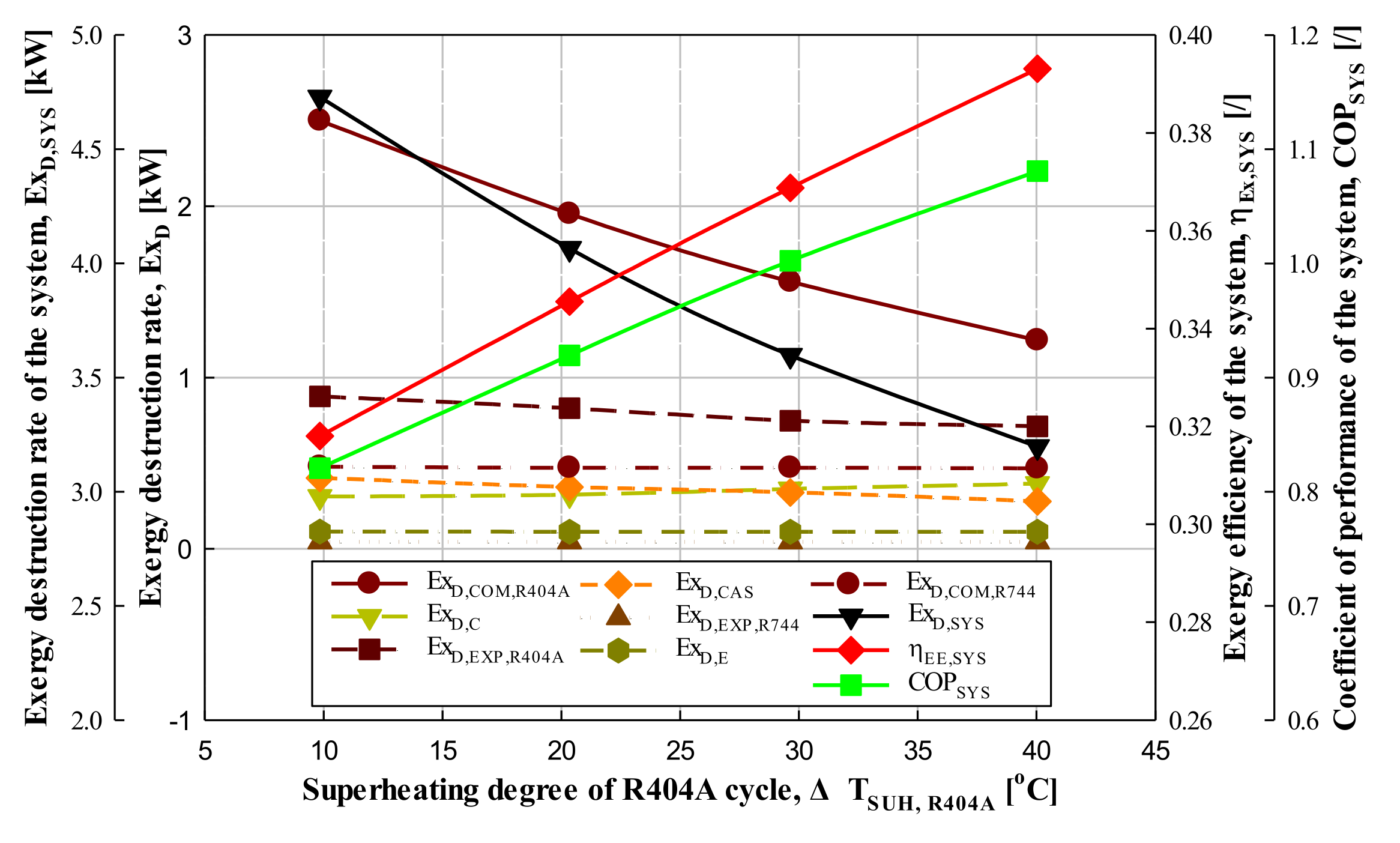
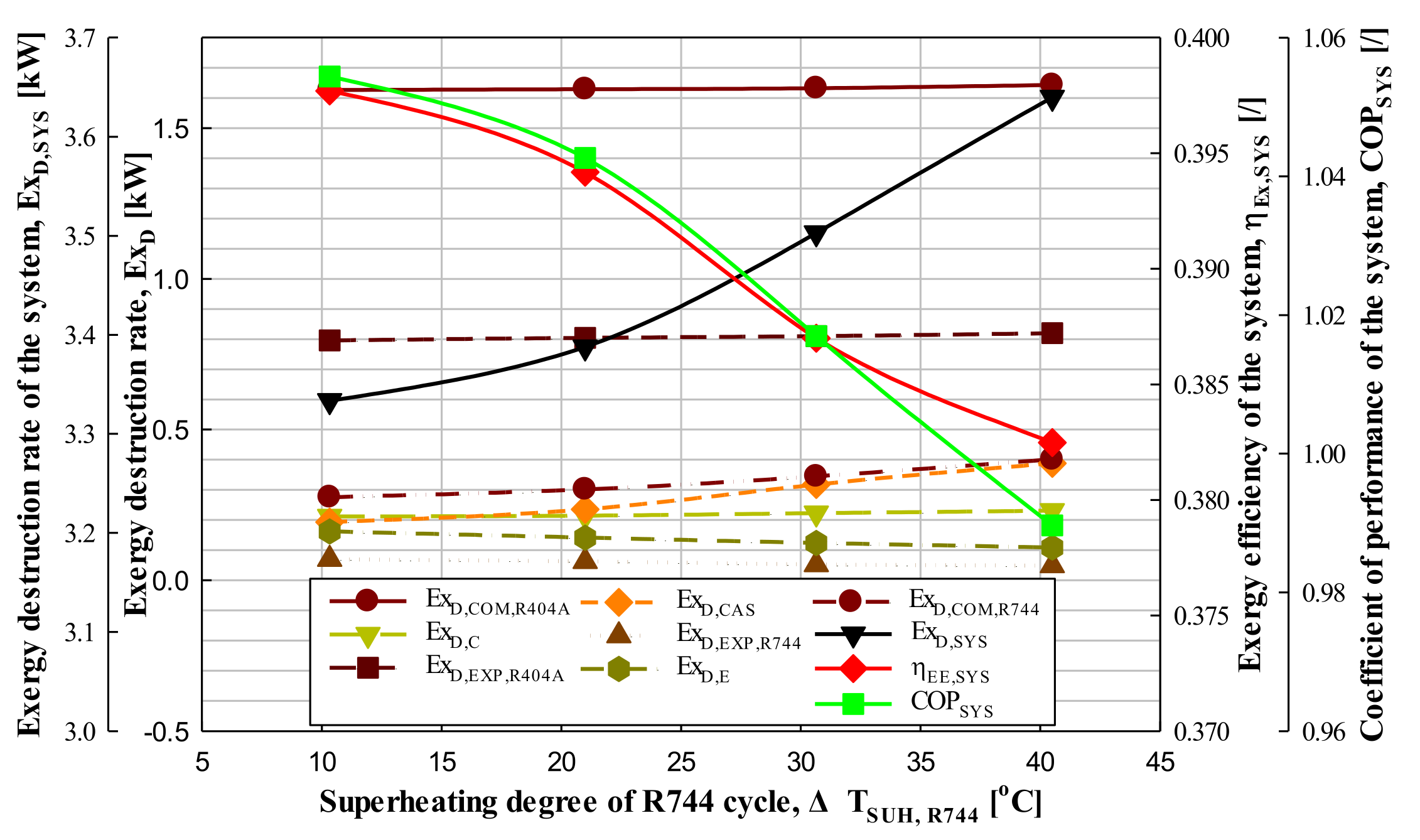
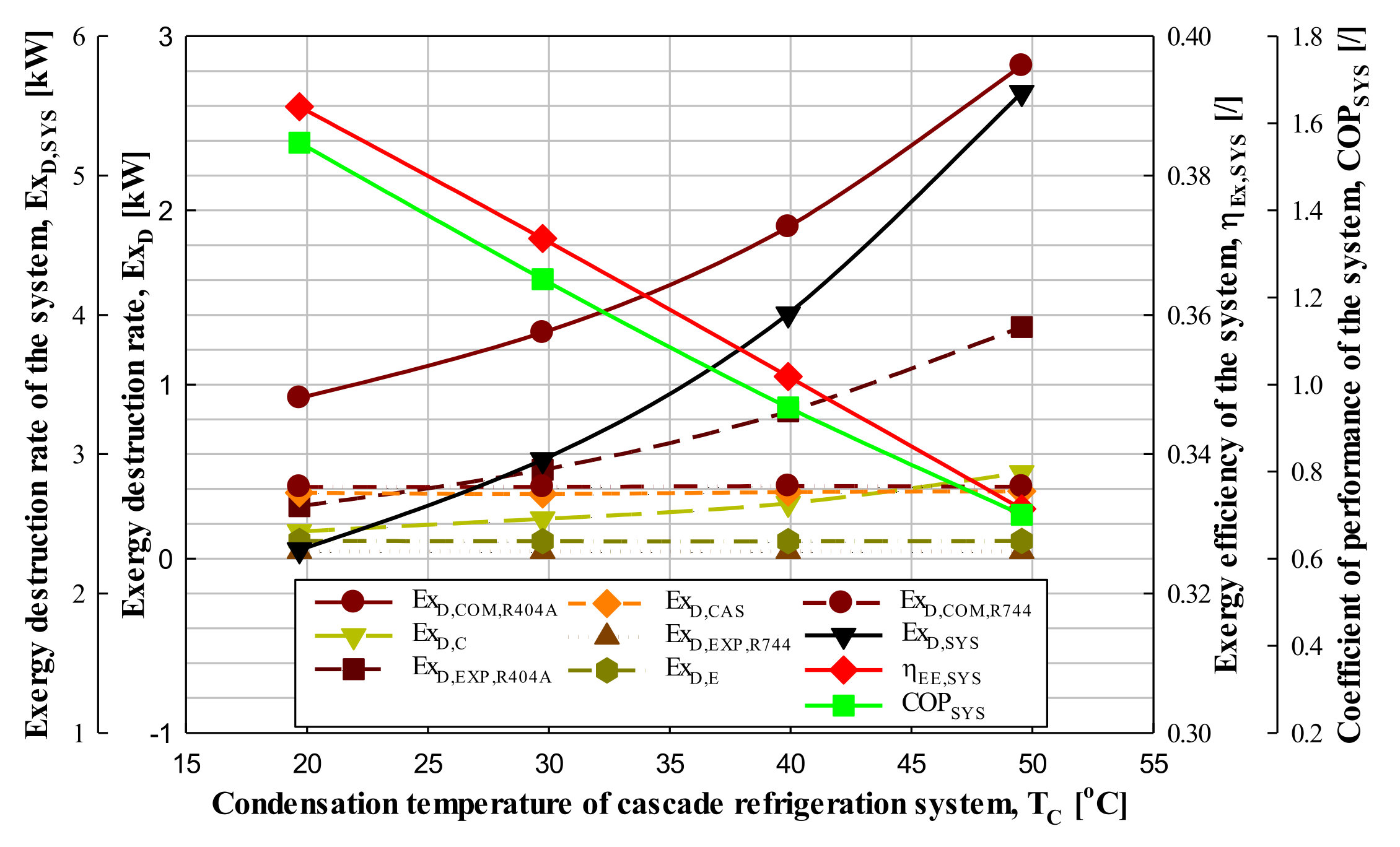
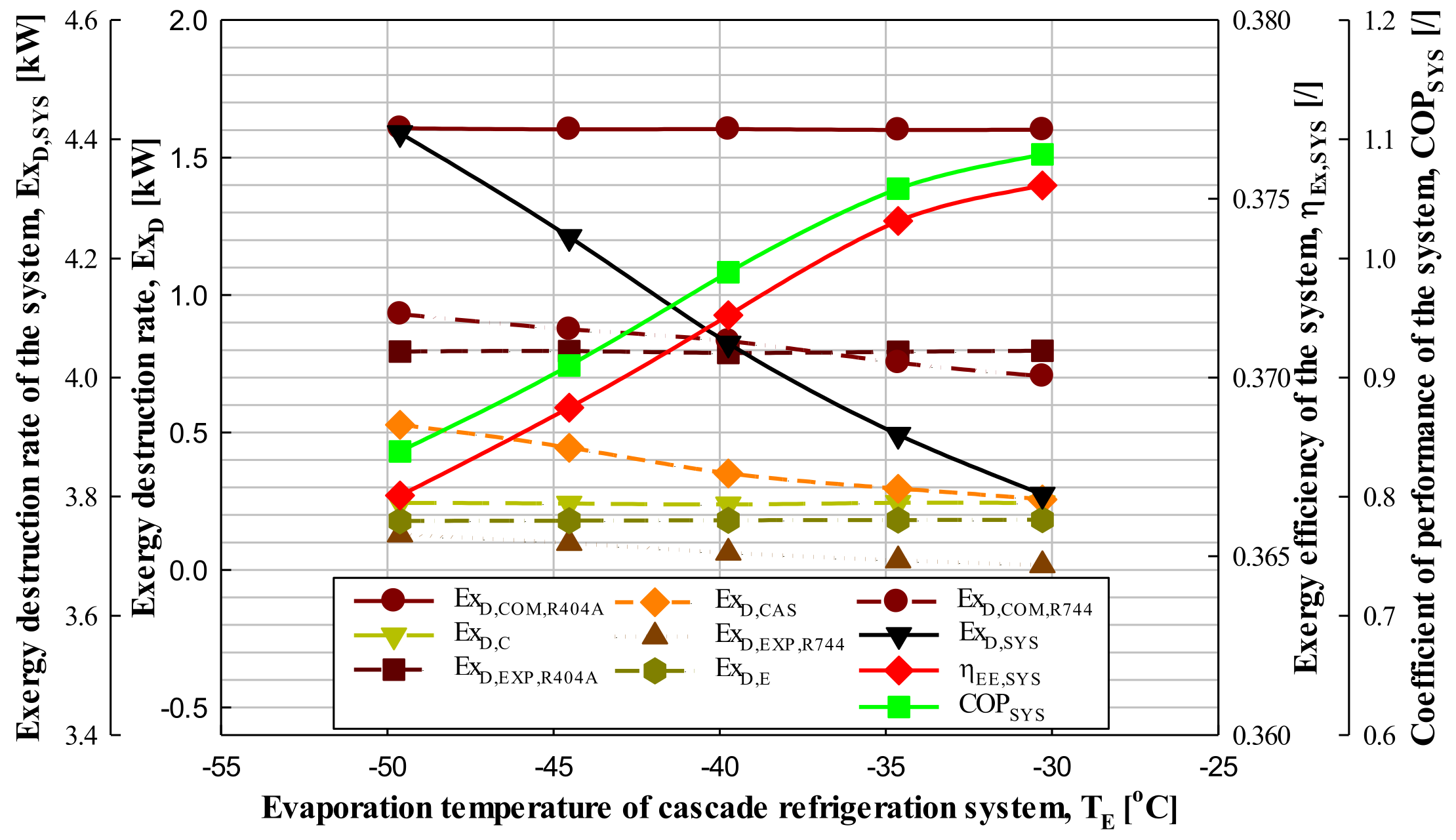
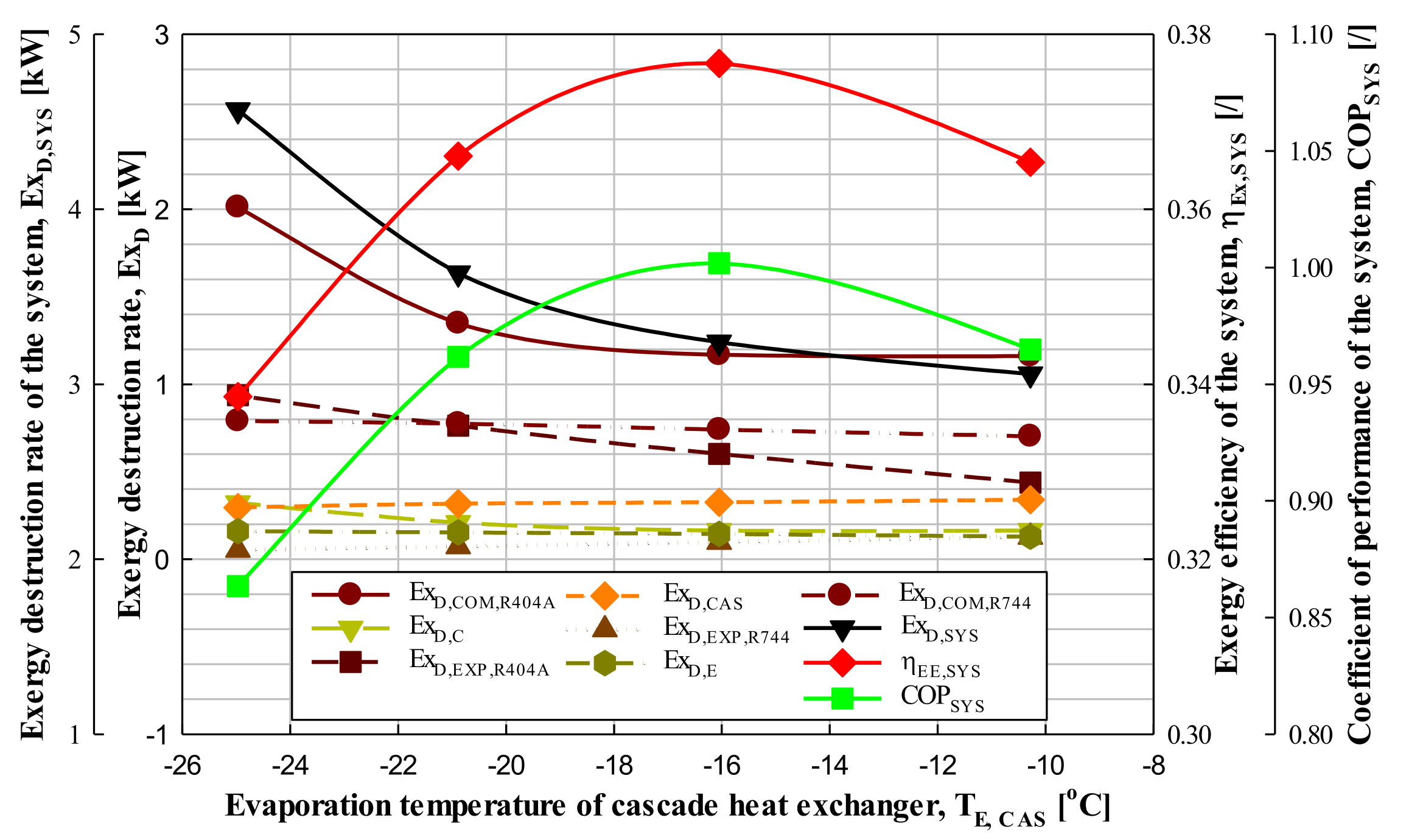
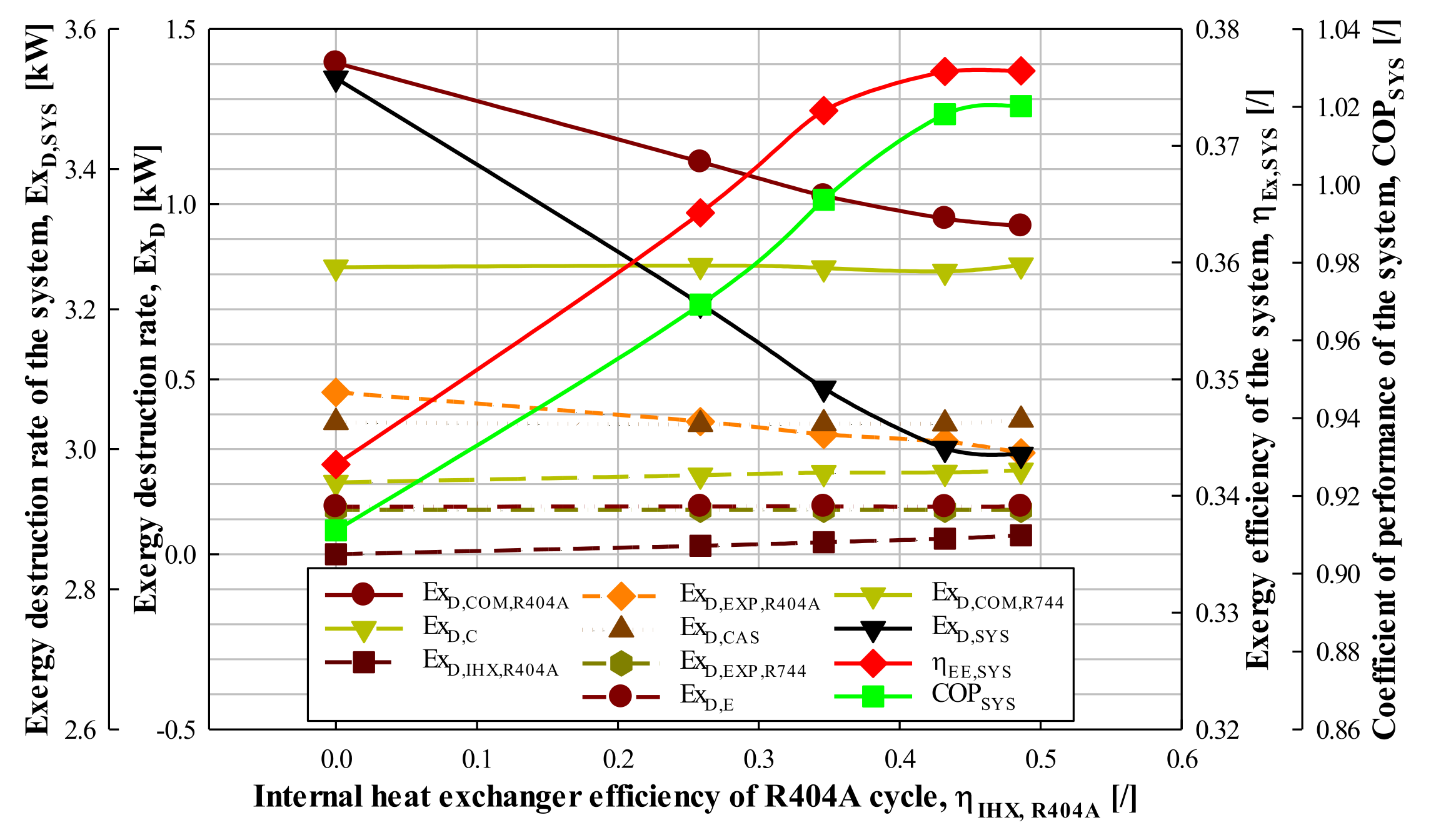
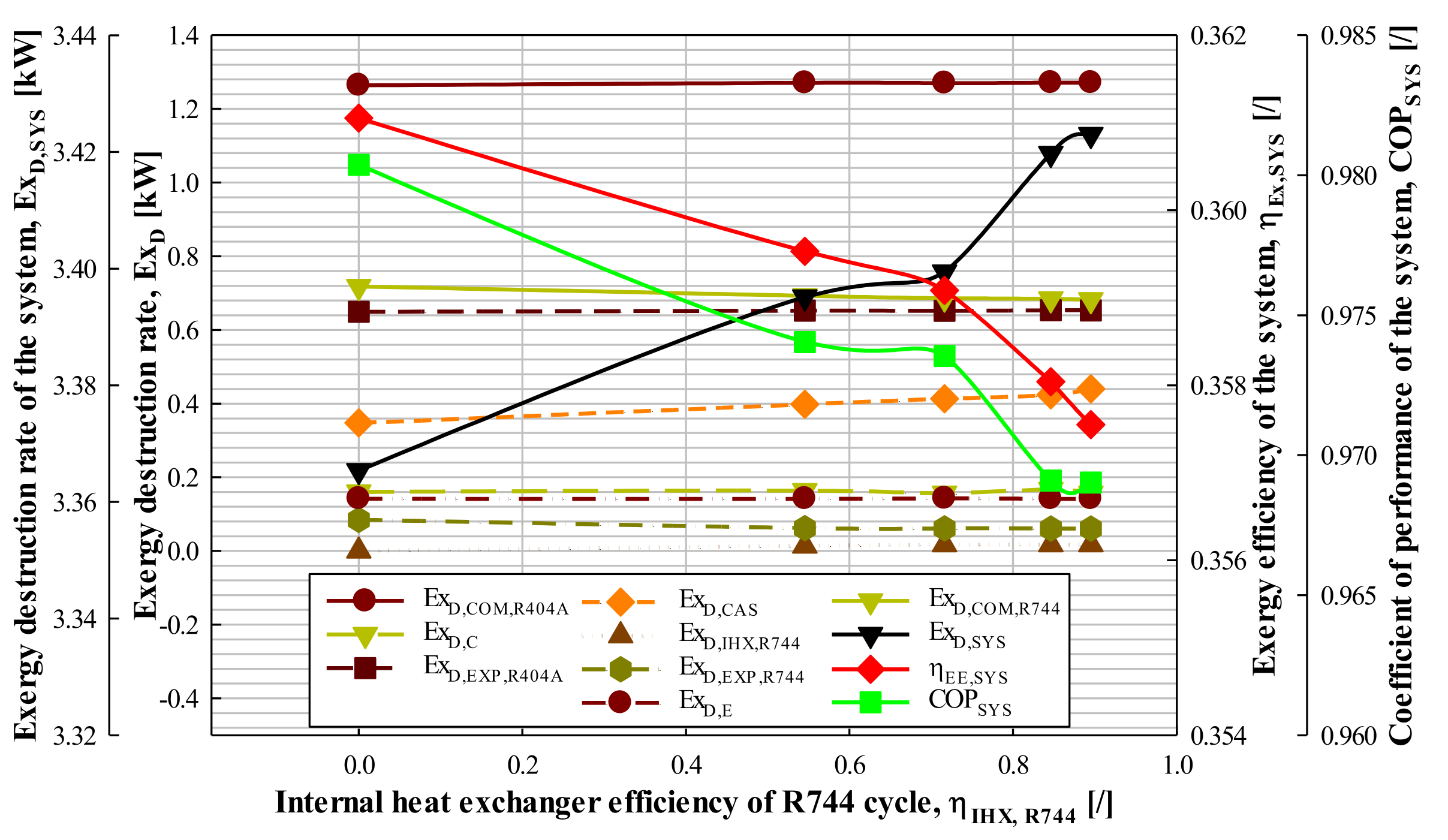
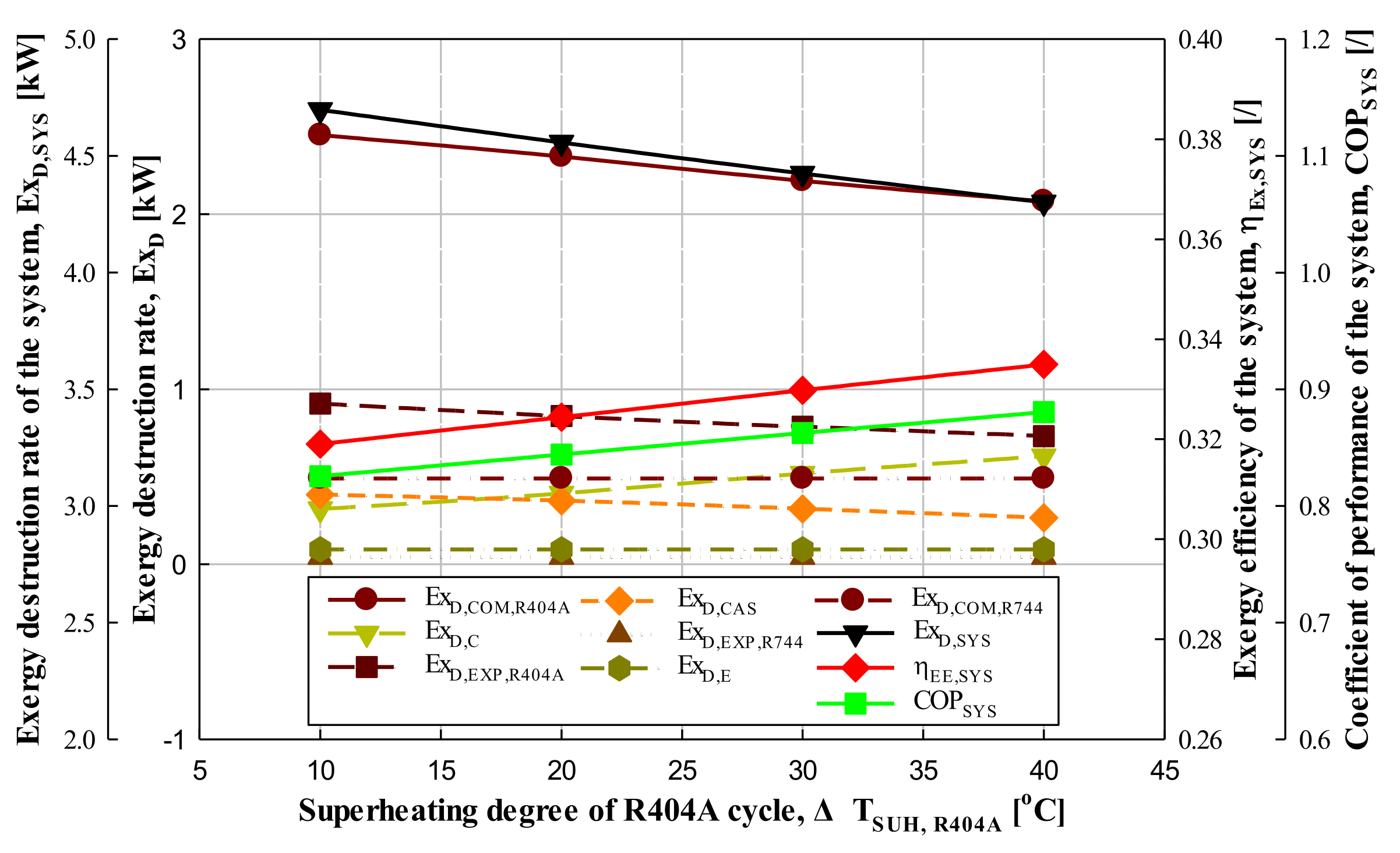
| Advantages of R744 |
|---|
|
| Cycle | Component | Range | Unit |
|---|---|---|---|
| High-temperature cycle (R404A) | Condensation temperature | 20, 30, 40 *, 50 | °C |
| Internal heat exchanger efficiency | 0 *, 1, 2, 3, 4 | stage | |
| Subcooling degree | 0 *, 5, 10, 15, 20 | °C | |
| Superheating degree | 10, 20 *, 30, 40 | °C | |
| Evaporation temperature | −30, −25 *, −20, −15, −10 | °C | |
| Temperature difference of cascade heat exchanger | 5 | °C | |
| Low-temperature cycle (R744) | |||
| Condensation temperature | −25, −20 *, −15, −10, −5 | °C | |
| Internal heat exchanger efficiency | 0 *, 1, 2, 3, 4 | stage | |
| Subcooling degree | 2 * | °C | |
| Superheating degree | 10, 20, 30, 40 * | °C | |
| Evaporation temperature | −50, −45, −40 *, −35, −30 | °C |
| Component | Characteristics |
|---|---|
| Evaporator Condenser Cascade heat exchanger R404A compressor R744 compressor | Hand-made, type: horizontal double tube, material: copper tube, internal diameter of inner tube: 11.46mm, internal diameter of outer tube: 33.27 mm, length of the evaporator: 8000 mm Alfa Laval, model: ACH-70X-50H-F, heat exchanged: 38.44 kW, heat transfer area: 2.45 m2 Alfa Laval, model: ACH-70X-50H-F, heat exchanged: 10.86 kW, heat transfer area: 2.45 m2 Bock, model: HGX34P/380-4S. Displacement with 1450 min−1: 33.1 m3h−1, no. of cylinders: 4, weight: 96 kg, max. power consumption: 11.1 kW Bock, model: HGX12P/40-4. Displacement with 1450 min−1: 4.4 m3h−1, no. of cylinders: 2, weight: 53 kg, max. power consumption: 2.1 kW |
| Cycle | Component | |||
|---|---|---|---|---|
| High Temperature Cycle (R404A) | Compressor (1→2) | |||
| Condenser (2→4) | ||||
| Internal heat exchanger (4→5, 8→1) | ) | |||
| Expansion valve (5→6) | ) | |||
| Cascade heat exchanger (6→8, 12→14) | ) | |||
| Low Temperature Cycle (R744) | ||||
| Compressor (11→12) | ||||
| Internal heat exchanger (14→15, 18→11) | ) | |||
| Expansion valve (15→16) | ) | |||
| Evaporator (16→18) |
| Parameters | Unit | Uncertainty |
|---|---|---|
| Mass flow rate | [kg/min] | ±0.01 |
| COP of cascade refrigeration system | [/] | ±0.0135 |
| Exergy destruction rate of system | [kW] | ±0.0175 |
| Temperature | [oC] | ±0.20 |
| [oC] | ±0.40 | |
| Pressure | [kPa] | ±5.27 |
| (Pressure drop) | [kPa] | ±0.01 |
| Mass flow rate of coolant | [kg/h] | ±7.53 |
Publisher’s Note: MDPI stays neutral with regard to jurisdictional claims in published maps and institutional affiliations. |
© 2022 by the author. Licensee MDPI, Basel, Switzerland. This article is an open access article distributed under the terms and conditions of the Creative Commons Attribution (CC BY) license (https://creativecommons.org/licenses/by/4.0/).
Share and Cite
Jeon, M.-J. Experimental Analysis of the R744/R404A Cascade Refrigeration System with Internal Heat Exchanger. Part 2: Exergy Characteristics. Energies 2022, 15, 1251. https://doi.org/10.3390/en15031251
Jeon M-J. Experimental Analysis of the R744/R404A Cascade Refrigeration System with Internal Heat Exchanger. Part 2: Exergy Characteristics. Energies. 2022; 15(3):1251. https://doi.org/10.3390/en15031251
Chicago/Turabian StyleJeon, Min-Ju. 2022. "Experimental Analysis of the R744/R404A Cascade Refrigeration System with Internal Heat Exchanger. Part 2: Exergy Characteristics" Energies 15, no. 3: 1251. https://doi.org/10.3390/en15031251
APA StyleJeon, M.-J. (2022). Experimental Analysis of the R744/R404A Cascade Refrigeration System with Internal Heat Exchanger. Part 2: Exergy Characteristics. Energies, 15(3), 1251. https://doi.org/10.3390/en15031251






